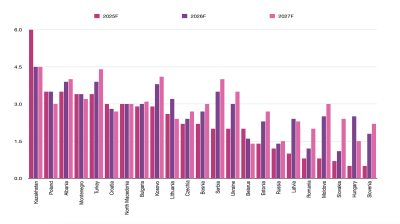Ukraine’s trade deficit has doubled to $42bn as exports fall and imports balloon. The balance of payments deficit is starting to turn into a serious problem that could undermine the country’s macroeconomic stability.
“Ukraine’s trade deficit is growing and turning into a serious structural challenge,” Kyiv School of Economics (KSE) said in its latest Macroeconomic handbook, released on October 28. “The deficit is now projected to reach $42bn in 2025 and is expected to remain seriously elevated over 2026-28. Closing the deficit will be quite challenging as imports are now effectively twice the size of exports, which means that the latter must grow at twice the rate of the former just to maintain the gap in absolute terms.”
Over the first eight months of 2025, goods exports declined by 4% y/y, driven by weaker shipments of agricultural products and minerals, though exports of metals and machinery increased. Total exports are now projected at $39.4bn for the year, a slight revision from the previous forecast of $40.2bn.
However, imports are surging and has doubled the trade deficit from the previous $20bn trade deficit. The ballooning trade imbalance comes on top of a widening budget deficit and a looming funding shortfall of at least $8bn-$19bn that has led some analysts to ask if Ukraine is able to avoid a macroeconomic collapse.
Between January and August, imports grew almost 20% y/y, prompting KSE to revise its full-year forecast upward from $75bn to $81.4bn. This includes broad-based increases in machinery, transport equipment, chemicals, and minerals. A key driver is the import of weaponry and military-related technology, according to KSE.
Civilian demand is also rising, including a sharp increase in electric vehicle purchases, ahead of the expiration of key tax benefits at year-end.
“Imports will continue to grow at a fast pace for the remainder of the war and beyond,” the KSE stated. “Post-war economic recovery will only accelerate this trend.”
As a result, Ukraine’s trade deficit is expected to widen from $33bn in 2024 to $42.1bn in 2025, with no immediate prospects for narrowing.
Ukraine’s exports forecast (2025)
· July forecast: $40.2bn
· Revised forecast: $39.4bn
Ukraine’s imports forecast (2025)
· July forecast: $75.0bn
· Revised forecast: $81.4bn
Ukraine’s trade deficit
· 2024: $33.0bn
· 2025: $42.1bn
The services balance, meanwhile, offers a more encouraging outlook. The KSE projects a gradual improvement, moving from a deficit of $5.6bn in 2024 to a surplus of $2bn by 2028, reflecting a long-delayed return of Ukrainian refugees, which is not expected to begin in earnest until the war ends. While services imports, particularly related to travel, remain high, exports are set to grow by 24.2% by 2028, boosted by IT and business services.
“Significant improvements will not materialise until the end of the war,” the KSE noted. “But the medium-term outlook for services is one of recovery and growth.”
Services balance trajectory
· 2024: -$5.6bn
· 2025: -$5.3bn
· 2026: -$3.0bn
· 2027: marginal deficit
· 2028: +$2.0bn surplus
The current account is also under pressure, due in part to a steep drop in foreign grants after the US backed away from supporting the war. Under the Biden administration the US accounted for about 40% of Ukraine’s funding, but since taking office this year US President Donald Trump has sent Ukraine no money. The EU is now entirely responsible for funding Ukraine’s military and government’s needs.
Secondary income inflows, primarily from international donors, reached $17.5bn in 2022 and remained around $14bn in 2023–2024. However, that figure is expected to fall to $7.4bn this year, and further to just $1–2bn in 2026–2027, as assistance shifts from grants to loans under mechanisms such as the EU’s Ukraine Facility and US aid ends.
“This shift is immaterial for overall financing needs,” the KSE noted, “but it moves support from the current account to the financial account, with consequences for external balances.”
Foreign grants (secondary income)
· 2022: $17.5bn
· 2023–24: ~$14bn
· 2025: $7.4bn
· 2026–27: $1–2bn
Current account deficit
· 2024: $15.1bn
· 2025: $33.6bn
· 2026: $39.2bn
With imports now twice the level of exports, and with donor funding becoming more limited and more conditional, the report concludes that Ukraine’s external position is entering a “structurally fragile” state—a situation likely to persist even in peacetime unless export capacity recovers and domestic production can offset the need for high-cost imports.
KSE warns that funding the deficit is going to bleed the country’s hard currency reserves and could ultimately undermine the value of the hryvna.
The NBU's gross reserves increased by 1.1% in September to $46.5bn thanks to fresh international financial assistance, but KSE says the trade deficit could see those shrink to as little as $12bn in the next two years unless exports can be boosted.
“Together with the war’s impact on capital flows and a projected sharp drop in committed foreign support, the trade deficit will dramatically reduce reserves to $12.4bn at the end of 2028.



Data
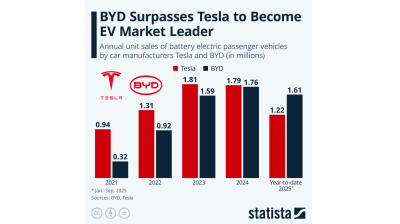
BYD surpasses Tesla to become EV market leader – Statista
While Chinese manufacturer BYD already pulled ahead of Tesla in production volume last year, with 1,777,965 battery electric vehicles (BEV) produced in 2024 (4,500 more than Tesla), the American manufacturer remained ahead in sales.
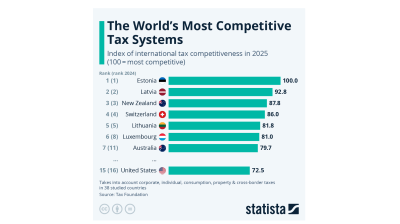
Estonia has the world’s most competitive tax systems for the 11th year in a row – STATISTA
The Tax Foundation has released its International Tax Competitiveness Index which highlights the most competitive tax rates in different countries around the world. For the 11th consecutive year, Estonia had the highest score in the index.
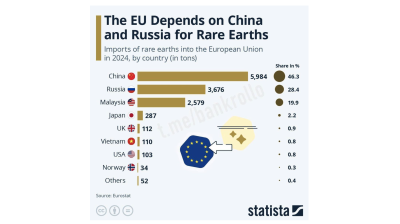
EU rare earth supply dominated by China and Russia - Eurostat
The European Union remains heavily dependent on China and Russia for rare earth imports, with nearly three-quarters of its supply sourced from the two countries in 2024, according to data published by Eurostat and reported by Statista.
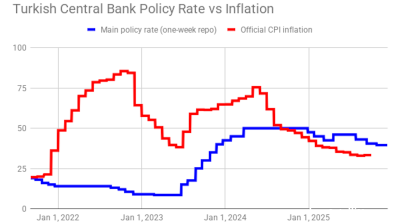
Turkey's central bank remains cautious, delivers 100bp rate cut
Decision comes on eve of next hearing in trial that could dislodge leadership of opposition CHP party.



